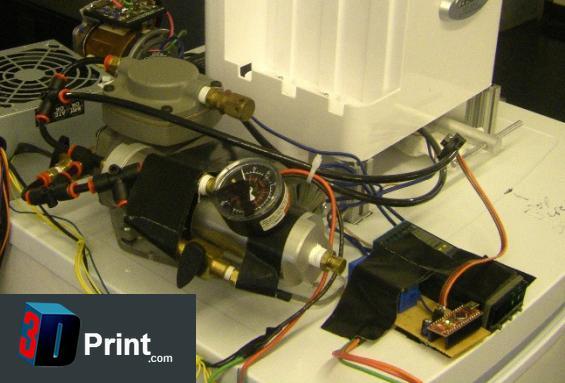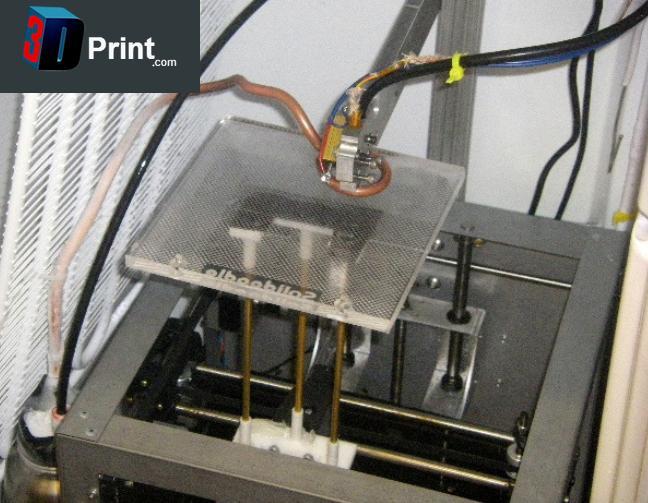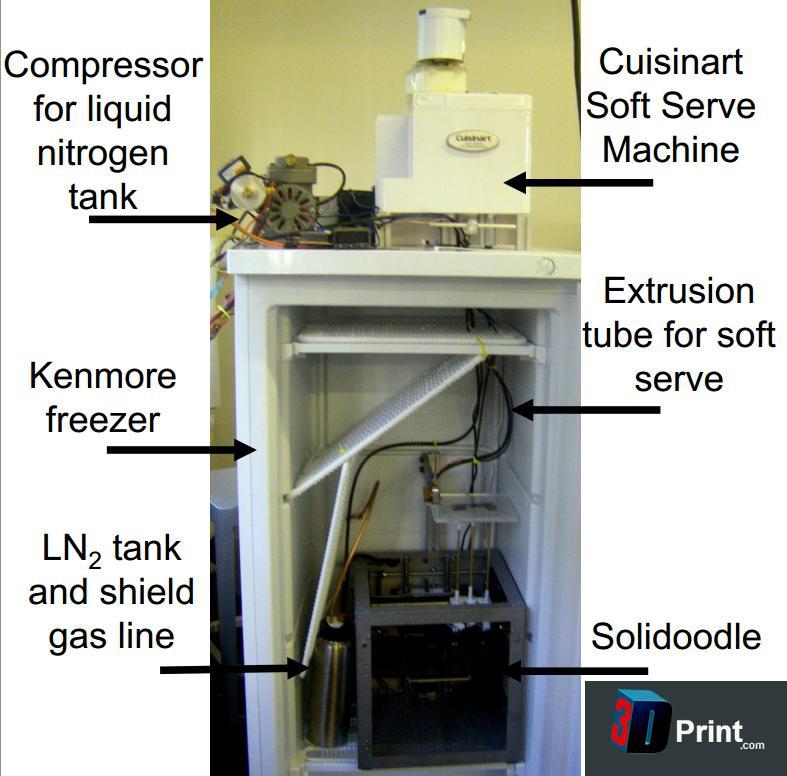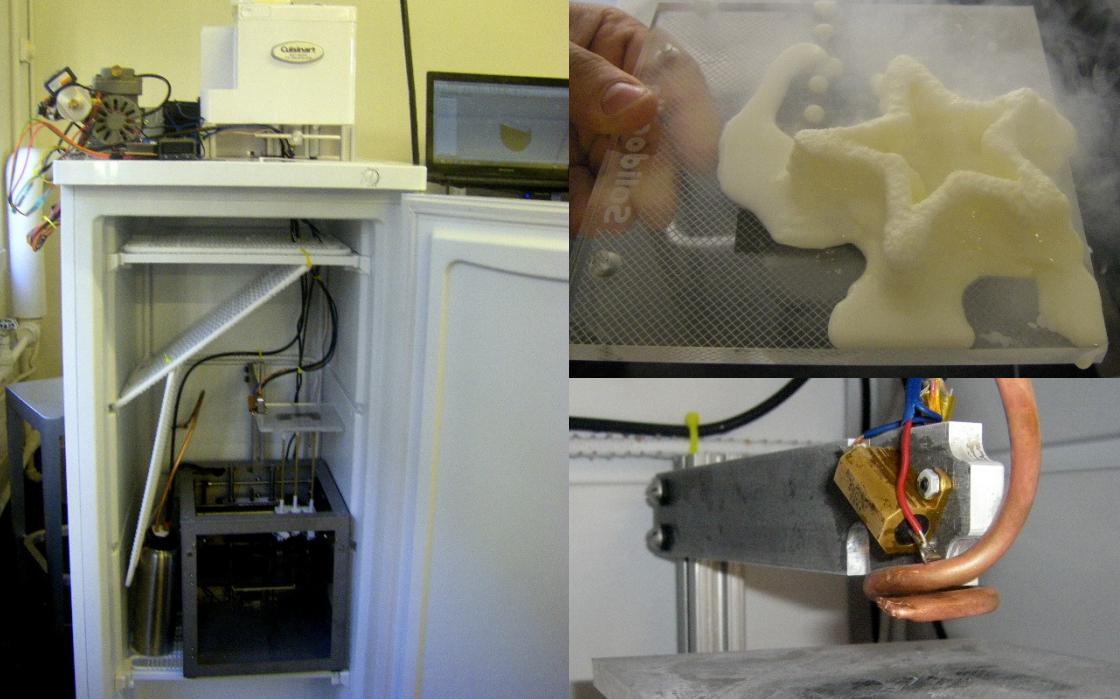I Scream, You Scream, We All Scream for 3D Printed Ice Cream? 3D Ice Cream Printer is Created at MIT
With today’s technology, we have the ability to 3D print in plastics, metals, ceramics, and even Nutella. Each and every day it seems as though we are introduced to a new type of material that is able to either be extruded from a 3D printer, or printed via another type of laser or light processing technology. It was only a matter of time before someone would come up with the clever idea of trying to 3D print objects out of ice cream.
3 Students (Kyle Hounsell, Kristine Bunker, and David Donghyun Kim) at MIT, as part of a project for Professor John Hart’s graduate class on additive manufacturing, in fact did come up with this tasty idea. Hart’s class focuses on the fundamentals of additive processing of polymers, metals, and ceramics, as well as machine designs and control strategies, 3D geometry representations and metrology, material properties and digital assembly. Students broke off into groups to create new 3D printing technology. Kyle, Kristine, and David decided to try and create a machine that could 3D print soft serve ice cream.
The idea behind this project came from the fact that the students believed there was a need for a “novel material” that could be printed using today’s 3D printing technology. They wanted to create a 3D printer that could print using soft serve ice cream, so they would be able to create edible treats in the shapes that they desired. Because of the fact that 3D printing will definitely be utilized by future generations in many different ways, the group wished to create a machine that would be able to introduce today’s younger generations to this incredible technology.
“The main reason we feel an Ice Cream 3D printer is an important addition to current additive manufacturing technology is that it interests children,” explained the students. “By combining this new technology of additive manufacturing with ice cream, we have found a way to interest children in technology and pursuing science and engineering in the future.”
In order to create their 3D ice cream printer, the students used and modified a Solidoodle 3D printer as well as a Cuisinart Soft Serve Ice Cream Maker. It also featured a cryogenic section used in order to make sure that the temperature on the ice cream is frozen evenly, once extruded.
“First, we needed to print into a cooled environment so that the ice cream would hold its shape once printed,” they explained. “We bought a small upright freezer which was large enough to both put the Solidoodle inside and allow for the full build volume we were aiming for.”
Another requirement was that they needed a shield gas to use to solidify the ice cream as soon as it was extruded from the 3D printer. To do this, they built a system, using a cryogen line that was bent in a circle to go around the entire extruder, that would spray liquid nitrogen onto the ice cream as it was extruded.
Next the students needed to modify the print bed of the Solidoodle 3D printer. Instead of printing inside of the normal build chamber on the printer, they needed to create a print bed which was located ouside of the enclosure, in order to fit both the ice cream extruder nozzle and the cryogen line.
The team realized that because of the rigid cryogen line which was attached to the extruder, they would also need to modify the printer so that the extruder became static. “We were able to accomplish this by taking the extruder head off of the Solidoodle and replacing it with a printed ABS fitting with three holes to allow vertical movement of thin rods holding the print bed above the Solidoodle,” they explained.
They also needed to utilize a special temperature controller to read the temperature of the extruder head, so that they could change the voltage on the fly, during test prints. The extrusion nozzle needed to be kept around 18-20 degrees fahrenheit. This is because soft serve ice cream is typically extruded from ice cream machines at around 18 degree and it melts at around 20 degrees.
The team ended up going with a 1/8″ diameter extruder head for the ice cream, in order to optimize the size and speed of the object that was being printed. “We felt that waiting more than 10-15 minutes for an ice cream to be printed would cause the consumer to lose interest,” they explained. “Additionally, this was a short enough time for the ice cream to keep its shape in the freezer.”
The 1/8″ diameter also allowed the printer to print in a fairly nice level of detail, in order to create “fun shapes”, while maintaining a resonable speed.
 After experimenting with various speeds, temperatures, and other factors, the team found just the right settings (4mm layer height) and speed (16mm/sec) in order to create tasty, unique looking ice cream treats.
After experimenting with various speeds, temperatures, and other factors, the team found just the right settings (4mm layer height) and speed (16mm/sec) in order to create tasty, unique looking ice cream treats.
“We imagine this technology being marketable in ice cream parlors such as Dairy Queen where customers can order an ice cream treat, wait 15 minutes, and see the shape they chose be created,” said the students. “Of course last, and more importantly, we aim to enjoy the ice cream after successful printing!”
Here is a video of the 3D ice cream printer in action
All in all, modifications will still need to be made to this 3D printer in order to print out objects for commercial use. Whether or not the students go on to develop this even further is yet to be determined. However, they have proven that it is possible to 3D print ice cream.
What do you think? Would you be interested in 3D printing ice cream? Do you think ice cream palors may one day use this technology to create custom ice cream treats for their patrons? Discuss in the 3D printed ice cream forum thread on 3DPB.com. Check out the additional video below showing the 3D ice cream printer finishing up its print.
Subscribe to Our Email Newsletter
Stay up-to-date on all the latest news from the 3D printing industry and receive information and offers from third party vendors.
Print Services
Upload your 3D Models and get them printed quickly and efficiently.
You May Also Like
3D Printing News Briefs, July 2, 2025: Copper Alloys, Defense Manufacturing, & More
We’re starting off with metals in today’s 3D Printing News Briefs, as Farsoon has unveiled a large-scale AM solution for copper alloys, and Meltio used its wire-laser metal solution to...
Etsy Design Rule Change Reduces Selection of 3D Printed Goods
Online marketplace Etsy has implemented a rule change requiring all 3D printed goods on the site to be original designs. The update to the site’s Creativity Standards states, ¨Items produced using...
Siraya Tech Introduces New Elastomer 3D Printing Materials, Including Foaming TPU
California company Siraya Tech, founded in 2019 with a focus on material science, customer focus, and agility, develops high-quality 3D printing materials that meet the needs of creators, hobbyists, and...
3D Printing News Briefs, April 12, 2025: RAPID Roundup
The news from last week’s RAPID+TCT in Detroit just keeps on coming! That’s why today’s 3D Printing News Briefs is another RAPID Roundup of more exciting announcements from the trade...







































